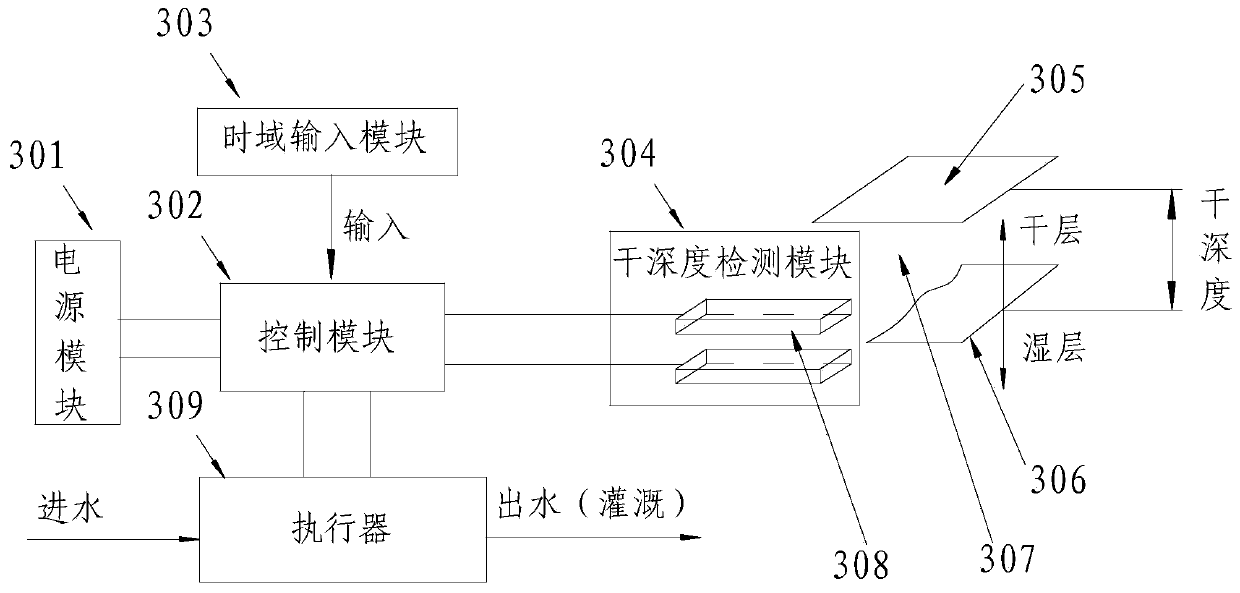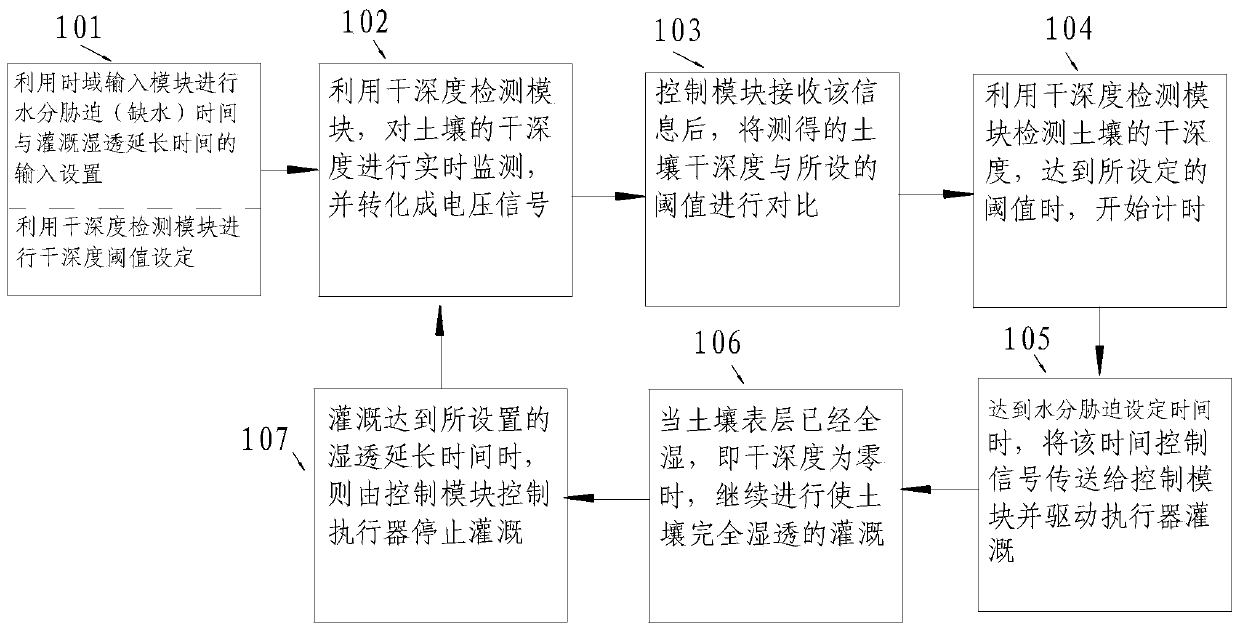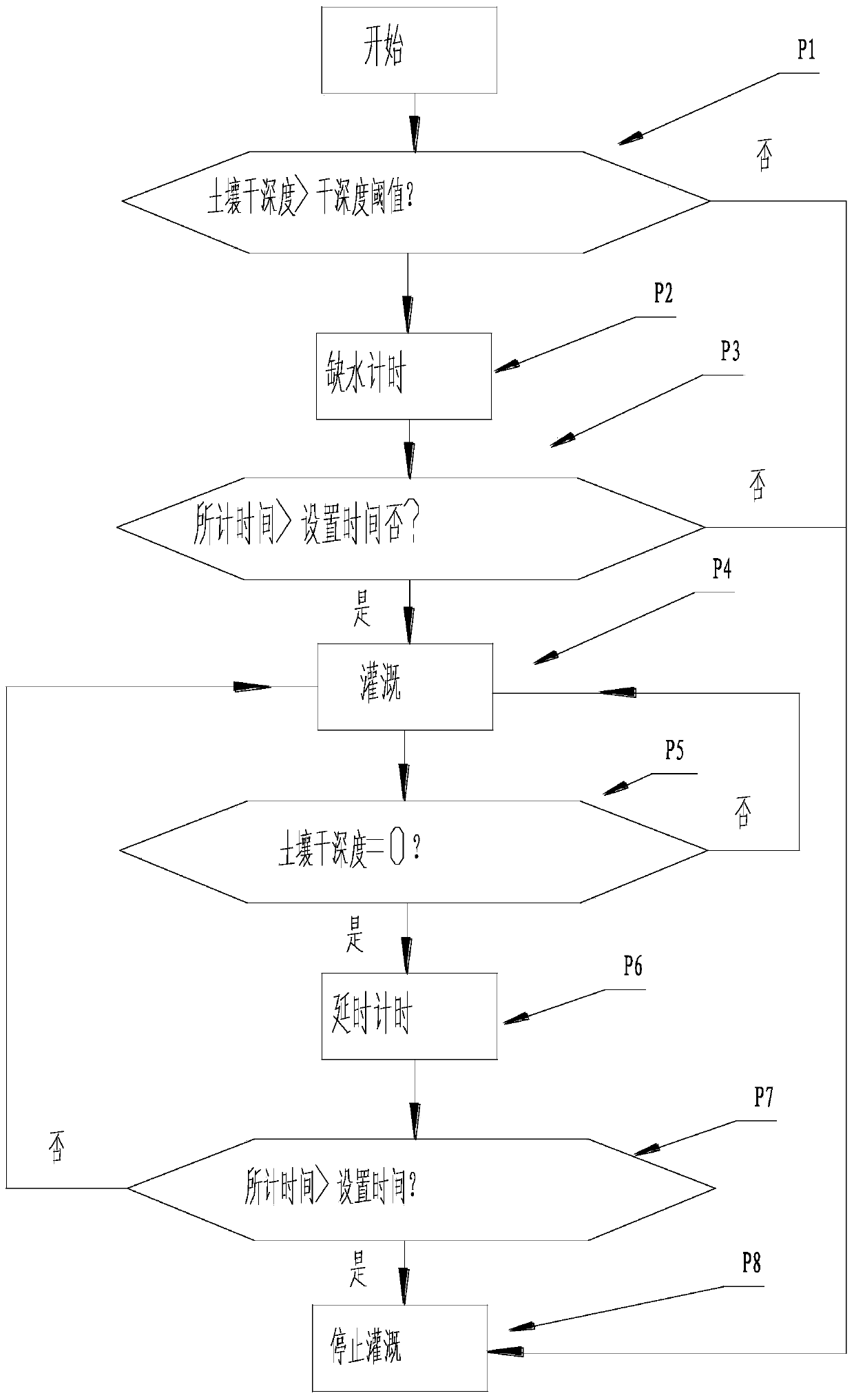[0006] (1) The use of
humidity sensors for irrigation based on
humidity control is difficult to fully reflect the
humidity of the soil, and the scientific rationality and economic efficiency are poor
①Due to the uneven distribution of soil
moisture, the unevenness of the humidity is not only manifested in the unevenness of the two-dimensional plane, but also in the unevenness of the three-dimensional
soil depth, so the collection of humidity is often difficult to represent If a large number of multi-point humidity detection is used in a large area of soil and in different depths, it will greatly increase the cost of irrigation, and it is also not conducive to the loosening and cultivation of irrigated plants, which is undoubtedly unrealistic; ②Different Plants have different requirements for soil
moisture in different growth periods, and constant soil
moisture may not be beneficial to plants; ③Because the
field soil environment has high requirements on the performance of humidity sensors, the price of commonly used sensors is also very expensive. It also greatly increases the cost of irrigation
In this way, simply using humidity to control irrigation is neither scientific, reasonable nor economical.
[0007] (2)
Humidity sensors for irrigation based on humidity control often do not necessarily save water
This is because: On the one hand, in order to prevent the drought death of plants and crops, the humidity sensor is usually buried shallowly, and shallow buried often leads to frequent irrigation, because the soil is not irrigated thoroughly, and most of the
irrigation water is kept in the soil. Therefore, the
soil surface is easy to dry and irrigation is started. At the same time, once the
soil surface is dry and easy to be wet after irrigation, the irrigation will stop soon, resulting in less
water content in the
soil surface and easy
drying, especially when the
sunlight intensity is high. When the temperature is high, the
terrain is high, or the wind is strong and the climate is dry, due to the poor
water retention of the soil, the water is easy to volatilize and lose. For example, the soil is sprayed in hot summer. Due to the high temperature effect, the water is quickly evaporated and the soil is quickly dried, and then sprayed repeatedly, the water is repeatedly evaporated and lost. On the surface, the amount of water used for each irrigation is reduced, which seems to save water, but due to the irrigation If it is carried out frequently, it will lead to waste of water, and the effect of
water saving will not be achieved; on the other hand, in order to prevent frequent irrigation, it is necessary to bury the humidity sensor deeply, and the deep burial may cause the soil to be irrigated for a long time. If the burial depth is not well grasped, it may also lead to the death of plants and crops. At the same time, due to the diversity and complexity of the soil, plants and crops, it often takes a long time for the water on the soil surface to penetrate into the deeply buried sensor. As a result, the soil There is more water on the top of the layer and less water on the bottom. Although the moisture content of the deep soil layer is reasonable, the moisture content of the
surface layer of the soil is too much and wastes water.
[0008] (3)
Humidity sensors are used for irrigation based on humidity control. It is inconvenient to use when implementing wheel irrigation. This is specifically manifested in: ① It is often necessary to control multiple solenoid valves through one controller, which will inevitably lead to buried wiring. It brings a lot of inconvenience, such as the distance between the solenoid valves is too far, or there are obstacles such as roads, ditches,
cement boards, stones, etc. In these occasions, it is not convenient to pull the wire to connect the solenoid valves, and it will also increase the cost of the project. However, if the solenoid valves are centrally controlled in a
short distance, it may lead to too long
piping routes and increase costs. At the same time, the small
diameter of the
piping will cause a large loss of
water pressure and cause energy waste; ② If the traditional simple humidity controller is used to control Each
solenoid valve is controlled one by one to implement wheel irrigation. Since the humidity sensor needs to set different humidity thresholds for each controller, this means that in order to achieve wheel irrigation, the irrigation volume and humidity of each wheel irrigation area are artificially caused. Similarly, regardless of the actual
water demand of plants and crops, especially for large areas of the same plants and crops, such irrigation methods are obviously not scientific enough
[0009] (4) Timed irrigation is adopted, and the time is treated as an equal-period change rule (such as periodic timing irrigation). Obviously, this kind of irrigation is relatively extensive and not scientific enough
On the one hand, this irrigation mode is too fixed to meet the changing
water demand of plants and crops in different growth periods. On the other hand, when irrigation is not needed on cloudy or rainy days, water will be wasted due to wrong irrigation. resource
[0010] (5) The combination of rainfall sensor and timing irrigation is used to judge whether it is sunny or rainy by the rainfall sensor, and to execute the pre-programmed irrigation program respectively. Although it is more advanced than regular irrigation, due to the uncertainty of
climate change after rain For example, it may be cloudy after rain, it may be sunny, it may be partly cloudy, even if it is purely cloudy and sunny, the intensity and time of sunshine, and the strength of wind,
atmospheric pressure and degree of humidity , as well as the level of ambient temperature, the height of the
terrain, the shading of light, the absorption and
evaporation of water in each growth period of plants, etc. will all affect the humidity of the soil.
Therefore, this pre-programmed irrigation cannot adapt to the changes brought about by various environments and soils, as well as changes in the growth of plants and crops, and it is difficult to adapt to the requirements of modern
agriculture and garden intelligent precision water-saving irrigation
[0011] (6) The concept of dry depth (that is, the depth of the dry layer of the soil) is not introduced, and it is difficult to control the dry and wet state of the three-dimensional soil, only considering the threshold control of the
soil humidity parameters or
soil moisture content at a certain point
[0012] (7) The concept of time domain is not introduced, and the time domain of irrigation is not considered, that is, time is not considered as a basic variable range, and there is no
water stress (water shortage) for plants and crops with different characteristics in different growth periods. The time and the length of the irrigation time are considered at the same time, only the upper and lower limits of the
soil moisture content are controlled, so that the time for the soil to be moderately dry is not sufficient, or because the soil that is irrigated by simple humidity control can be irrigated immediately, the soil is kept at the same level for a long time. The relatively constant humidity range with little change will cause rotten roots of plants and crops, diseases and
insect pests, and it is difficult to fully achieve the effects of
water saving, high quality, and production increase of regulated deficit irrigation, or the collection points of humidity (moisture) sensors, including the depth, cannot accurately represent The moisture status of the three-dimensional soil, the irrigation time is not enough to get wet, or the soil is not dry enough to start irrigation
 Login to View More
Login to View More  Login to View More
Login to View More 


